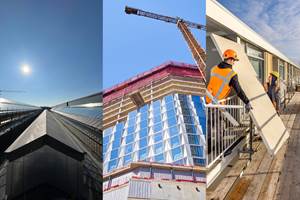Changing future outcomes with the materials of the future
This past October was plagued with a series of unfortunate natural disasters that, amidst ongoing travel for CW, has provided a poignant reminder of composites’ importance in facing future events.

Linden S. Blue is recognized with an award at NIAR′s innovation summit. Source (All images) | CW
The first few weeks of this past October have been a lot to take in. While preparing this issue of CW, my hometown was devastated by Hurricane Helene. I grew up in western North Carolina, practically on the border of Tennessee. Watching the true measure of Helene’s destruction in places where I spent much of my youth — emerging largely through videos posted via social media — has brought the topic of climate change that much closer to home for me and I imagine for many of you who may also be from or living in that area.
With the aftermath of Helene as a backdrop, I set out to attend two composites industry events — the National Institute for Aviation Research’s (NIAR) ATLAS Composites and Innovation Summit at Wichita State University in Kansas, and CW’s own Carbon Fiber conference in Charleston, South Carolina.
NIAR’s innovation summit provided a good distraction from the constant feed of images from Helene, offering an inspiring look at the ATLAS center’s latest composites innovation capabilities, as well as several newly added facilities since CW last toured in 2022. A keynote by Linden S. Blue, vice chairman of General Dynamics, whose career in aviation includes Beech Aircraft, Raytheon Co. and Learjet Corp., offered a reminder of the important work that our industry is involved in from playing a key role in the defense sector to enabling new strides toward renewable energy.
I left Wichita inspired and made my way to South Carolina for Carbon Fiber 2024, constantly checking updates from Hurricane Milton, which was making its way toward Florida. Networking with conference attendees, I listened to stories of their own experiences through these storms, from stories of travel plans that were affected to concerns for family and friends to damage to their homes or businesses. A group of Carbon Fiber attendees even discussed with me about the idea to fabricate lightweight composite bridges for deployment in affected communities.
When natural disasters of this magnitude strike, it is easy to feel helpless. No amount of outreach or donation seem like enough when people have lost their homes, their livelihoods or their very lives. But when I see colleagues in the industry looking to their work and areas of expertise for answers, I become truly inspired.

Myriam Yagoubi discusses carbon fiber supply and demand at this year's Carbon Fiber.
Many of the themes of this year’s conference — and so much of the work being done in the composites industry — revolved around sustainability and the quest for more environmentally friendly solutions for everything from transportation and energy to infrastructure. During the pre-conference seminar, Myriam Yagoubi of Future Materials Group (FMG) spoke about the growth the composites industry can anticipate in the next two decades, with wind and pressure vessels comprising the largest areas of projected growth, making up 51% and 20% of future carbon fiber use, respectively. Additional sessions delved into the topics of wind energy, life cycle assessment of carbon fiber, renewable energy storage solutions and the reclaim and reuse of carbon fiber at the end of product life.
Natural disasters like Helene are reminder that the actions we take as a society have an effect on the world around us — climate change is a reality we have to contend with. In looking to the future of manufacturing, we must continue to explore sustainable technologies and processes that improve efficiencies, reduce waste and lower carbon emissions. We must continue to innovate and work to find new material solutions that can enable advances in transportation, renewable energy and infrastructure. The materials used to rebuild the buildings and bridges that were damaged or destroyed should be considered for their ability to withstand future weather events.
The problems in front of us are existential in nature, and there is a real opportunity to make a difference. Near the end of his keynote address in Wichita, Linden S. Blue broke into a verse of “God Bless America.” He had been speaking of hope in the face of war, political unrest and climate change — and then he decided to lead a room full of scientists, engineers and composites industry professionals in song. It was a poignant reminder that the call to meet the challenges head on is a charge for all of us.
Related Content
Bio-based, fire-resistant composites become mainstream
Projects use Duplicor prepreg panels with highest Euroclass B fire performance without fire retardants for reduced weight, CO2 footprint in sustainable yet affordable roofs, high-rise façades and modular housing.
Read MoreComposites end markets: Sports and recreation (2025)
The use of composite materials in high-performance sporting goods continues to grow, with new advancements including thermoplastic and sustainability-focused materials and automated processes.
Read MoreASCEND program completion: Transforming the U.K.'s high-rate composites manufacturing capability
GKN Aerospace, McLaren Automotive and U.K. partners chart the final chapter of the 4-year, £39.6 million ASCEND program, which accomplished significant progress in high-rate production, Industry 4.0 and sustainable composites manufacturing.
Read MoreBladder-assisted compression molding derivative produces complex, autoclave-quality automotive parts
HP Composites’ AirPower technology enables high-rate CFRP roof production with 50% energy savings for the Maserati MC20.
Read MoreRead Next
Revisiting the OceanGate Titan disaster
A year has passed since the tragic loss of the Titan submersible that claimed the lives of five people. What lessons have been learned from the disaster?
Read MoreMaking an effort to move industry forward
A reflection on the insights, connections and collaboration afforded by attending composite industry events like SPE ACCE and CAMX.
Read MoreComposites reinvent transportation
Celebrating National Composites Week, CW shares ways in which composites continue to evolve mass transit.
Read More






















